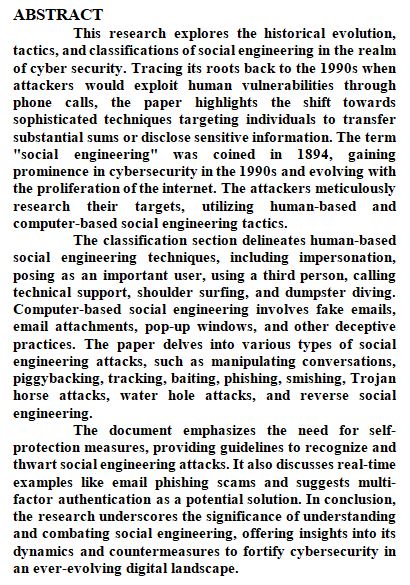Unmasking the Evolution of Social Engineering in Cybersecurity: Techniques, Vulnerabilities, and Countermeasures
DOI:
https://doi.org/10.5281/zenodo.10686537Keywords:
Attack Techniques, Cybersecurity, Multi-Factor Authentication, Phishing Scams, Social EngineeringAbstract
This research explores the historical evolution, tactics, and classifications of social engineering in the realm of cyber security. Tracing its roots back to the 1990s when attackers would exploit human vulnerabilities through phone calls, the paper highlights the shift towards sophisticated techniques targeting individuals to transfer substantial sums or disclose sensitive information. The term "social engineering" was coined in 1894, gaining prominence in cybersecurity in the 1990s and evolving with the proliferation of the internet. The attackers meticulously research their targets, utilizing human-based and computer-based social engineering tactics.
The classification section delineates human-based social engineering techniques, including impersonation, posing as an important user, using a third person, calling technical support, shoulder surfing, and dumpster diving. Computer-based social engineering involves fake emails, email attachments, pop-up windows, and other deceptive practices. The paper delves into various types of social engineering attacks, such as manipulating conversations, piggybacking, tracking, baiting, phishing, smishing, Trojan horse attacks, water hole attacks, and reverse social engineering.
The document emphasizes the need for self-protection measures, providing guidelines to recognize and thwart social engineering attacks. It also discusses real-time examples like email phishing scams and suggests multi-factor authentication as a potential solution. In conclusion, the research underscores the significance of understanding and combating social engineering, offering insights into its dynamics and countermeasures to fortify cybersecurity in an ever-evolving digital landscape.
Downloads

Downloads
Published
How to Cite
Issue
Section
License
Copyright (c) 2024 Dr. Paravathi C, Dhanyashree G, Yeshaswini R, Lisha S

This work is licensed under a Creative Commons Attribution 4.0 International License.











